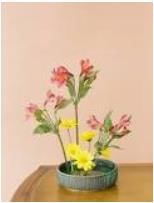Class 6 Exam > Class 6 Questions > Ikebana is Japanese art ofa)Paper craftb)Dres...
Start Learning for Free
Ikebana is Japanese art of
- a)Paper craft
- b)Dress designing
- c)Tree farming
- d)Flower arrangement
Correct answer is option 'D'. Can you explain this answer?
Most Upvoted Answer
Ikebana is Japanese art ofa)Paper craftb)Dress designingc)Tree farming...
What is Ikebana?
Ikebana is the traditional Japanese art of flower arrangement. It goes beyond merely placing flowers together; it reflects the beauty of nature and harmony through careful design and composition.
Historical Background
- Ikebana has roots in Buddhist ceremonial offerings, dating back to the 6th century.
- Over the centuries, it evolved into a distinct art form, emphasizing simplicity and elegance.
Key Principles of Ikebana
- Asymmetry: Unlike Western floral arrangements, Ikebana often employs asymmetrical designs to create dynamic balance.
- Line and Form: The arrangement focuses on the lines and shapes of the materials used, which can include not only flowers but also branches, leaves, and even twigs.
- Space and Minimalism: Empty space is as important as the flowers themselves. This principle highlights the significance of each element in the arrangement.
Materials Used
- Flowers: A variety of flowers can be used, depending on the season and the message one wants to convey.
- Foliage: Leaves and branches play an essential role in providing structure and contrast.
- Containers: The choice of vase or container is crucial, as it can enhance the overall aesthetic of the arrangement.
Conclusion
Ikebana is much more than just flower arrangement; it is a meditative practice that encourages mindfulness and appreciation of nature's beauty. This art form continues to thrive, inspiring many with its elegance and simplicity.
Ikebana is the traditional Japanese art of flower arrangement. It goes beyond merely placing flowers together; it reflects the beauty of nature and harmony through careful design and composition.
Historical Background
- Ikebana has roots in Buddhist ceremonial offerings, dating back to the 6th century.
- Over the centuries, it evolved into a distinct art form, emphasizing simplicity and elegance.
Key Principles of Ikebana
- Asymmetry: Unlike Western floral arrangements, Ikebana often employs asymmetrical designs to create dynamic balance.
- Line and Form: The arrangement focuses on the lines and shapes of the materials used, which can include not only flowers but also branches, leaves, and even twigs.
- Space and Minimalism: Empty space is as important as the flowers themselves. This principle highlights the significance of each element in the arrangement.
Materials Used
- Flowers: A variety of flowers can be used, depending on the season and the message one wants to convey.
- Foliage: Leaves and branches play an essential role in providing structure and contrast.
- Containers: The choice of vase or container is crucial, as it can enhance the overall aesthetic of the arrangement.
Conclusion
Ikebana is much more than just flower arrangement; it is a meditative practice that encourages mindfulness and appreciation of nature's beauty. This art form continues to thrive, inspiring many with its elegance and simplicity.
Free Test
| FREE | Start Free Test |
Community Answer
Ikebana is Japanese art ofa)Paper craftb)Dress designingc)Tree farming...
Ikebana is Japanese art of flower arrangement.



|
Explore Courses for Class 6 exam
|

|
Question Description
Ikebana is Japanese art ofa)Paper craftb)Dress designingc)Tree farmingd)Flower arrangementCorrect answer is option 'D'. Can you explain this answer? for Class 6 2025 is part of Class 6 preparation. The Question and answers have been prepared according to the Class 6 exam syllabus. Information about Ikebana is Japanese art ofa)Paper craftb)Dress designingc)Tree farmingd)Flower arrangementCorrect answer is option 'D'. Can you explain this answer? covers all topics & solutions for Class 6 2025 Exam. Find important definitions, questions, meanings, examples, exercises and tests below for Ikebana is Japanese art ofa)Paper craftb)Dress designingc)Tree farmingd)Flower arrangementCorrect answer is option 'D'. Can you explain this answer?.
Ikebana is Japanese art ofa)Paper craftb)Dress designingc)Tree farmingd)Flower arrangementCorrect answer is option 'D'. Can you explain this answer? for Class 6 2025 is part of Class 6 preparation. The Question and answers have been prepared according to the Class 6 exam syllabus. Information about Ikebana is Japanese art ofa)Paper craftb)Dress designingc)Tree farmingd)Flower arrangementCorrect answer is option 'D'. Can you explain this answer? covers all topics & solutions for Class 6 2025 Exam. Find important definitions, questions, meanings, examples, exercises and tests below for Ikebana is Japanese art ofa)Paper craftb)Dress designingc)Tree farmingd)Flower arrangementCorrect answer is option 'D'. Can you explain this answer?.
Solutions for Ikebana is Japanese art ofa)Paper craftb)Dress designingc)Tree farmingd)Flower arrangementCorrect answer is option 'D'. Can you explain this answer? in English & in Hindi are available as part of our courses for Class 6.
Download more important topics, notes, lectures and mock test series for Class 6 Exam by signing up for free.
Here you can find the meaning of Ikebana is Japanese art ofa)Paper craftb)Dress designingc)Tree farmingd)Flower arrangementCorrect answer is option 'D'. Can you explain this answer? defined & explained in the simplest way possible. Besides giving the explanation of
Ikebana is Japanese art ofa)Paper craftb)Dress designingc)Tree farmingd)Flower arrangementCorrect answer is option 'D'. Can you explain this answer?, a detailed solution for Ikebana is Japanese art ofa)Paper craftb)Dress designingc)Tree farmingd)Flower arrangementCorrect answer is option 'D'. Can you explain this answer? has been provided alongside types of Ikebana is Japanese art ofa)Paper craftb)Dress designingc)Tree farmingd)Flower arrangementCorrect answer is option 'D'. Can you explain this answer? theory, EduRev gives you an
ample number of questions to practice Ikebana is Japanese art ofa)Paper craftb)Dress designingc)Tree farmingd)Flower arrangementCorrect answer is option 'D'. Can you explain this answer? tests, examples and also practice Class 6 tests.

|
Explore Courses for Class 6 exam
|

|
Signup for Free!
Signup to see your scores go up within 7 days! Learn & Practice with 1000+ FREE Notes, Videos & Tests.























